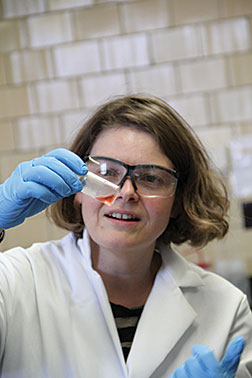- Number 429 |
- December 22, 2014
Anja Mudring joins Ames Lab to study ionic liquids

New, but already part of the family:
Anja Mudring joins Ames Laboratory and
Critical Materials Institute to study ionic
liquids after long-time Ames Lab connections.
Anja Mudring is new to the Ames Laboratory as a full-time scientist, but her ties to the Lab date back to 1997 when she first came for a 2-week fellowship trip as a graduate student.
“I read in my chemistry text book about molten salts and ionic liquids and I thought it was so interesting. And a name kept popping up: John Corbett, here at Ames Laboratory. So, I wrote to John and he invited me to come here to Ames for my fellowship trip.”
Mudring returned as a postdoctoral research associate from 2001-2003, and, even after she returned to Germany to start her own research group, she continued to visit Ames Laboratory for about a month each year.
“Always in the winter. I’ve always liked the quietness in Ames in the winter. The summer feels too hot to me, so I vowed to always only come in winter.”
But then the opportunity came to join Ames Laboratory -- all four seasons of the year.
“When the Critical Materials Institute started at Ames Laboratory I learned of the openings, I applied. I already knew I loved Ames and the people here. And the research opportunities provided by the CMI were excellent,” says Mudring. “So here I am. Happy to be here all year long, and excited to continue the kind of work that brought me to the Ames Laboratory all those years ago: ionic liquids”
Anja Mudring is harnessing the promising qualities of ionic liquids, salts in a liquid state, to optimize processes for critical materials.
“Ionic liquids have a lot of useful qualities – they are safer than the materials they would replace, are sustainable and multi-functional, but most useful for materials processing is that ionic liquids are customizable. They are made up of two parts: the cation and the anion. We can play around with the chemical identities of each of those components and that opens the doors to huge amount of options,” says Mudring. “That means we can really engineer ionic liquids with specific functions in mind.”
One such function is improving the rare-earth separation process, either for use extracting rare earths from ore or recycling rare earths from discarded magnets.
“We are tuning the ionic liquids in such a way that they dissolve rare-earth oxides and then we’re using electrodeposition, where electricity is run through a liquid to create a chemical change to get the rare earth in metal form,” says Mudring, who is also a professor of materials science and engineering at Iowa State University.
Traditionally, electrodeposition processes are extremely high temperature and often require corrosive chemicals. But Mudring’s process requires much lower temperatures and ionic liquids are less hazardous, so less energy is needed and the process is safer and greener.
Mudring’s group is also using ionic liquids to create phosphors for compact fluorescent light bulbs.
“We’re using ionic liquids, putting them in a microwave, energizing them, and creating a phosphors material. The phosphors particles are less than 10 nanometers, which means they do not scatter light, key for optical applications like for compact fluorescent light bulbs,” says Mudring.
Better yet, Mudring’s process also reduces the amount of rare-earth materials required in the process, and may someday make it possible to replace mercury vapor with less-hazardous noble gases in CFLs. And looking farther down the road, the new phosphors could also be used in LEDs as they continue to replace CFLs.
“Ionic liquids are the key to the improvements in this material synthesis,” says Mudring. “They function as the solvent, a safer one than an alcohol or other combustible solvent. And they are also the reaction partner: Here, the ionic liquid is the fluoride source, so we can omit hazardous hydrofluoric acid from the process. Again, that makes the process safer and cleaner. And they even function to stabilize the nanoparticles created in the process, eliminating the need for an additional stabilizer. Three functions in one! Add to that how efficiently ionic liquids take up microwave energy and there’s just huge potential there for improving materials synthesis.”Submitted by DOE's Ames Laboratory
